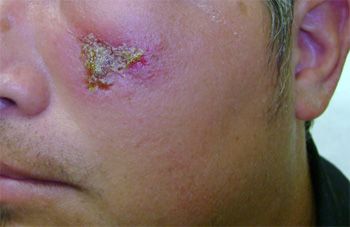- Clinical Technology
- Adult Immunization
- Hepatology
- Pediatric Immunization
- Screening
- Psychiatry
- Allergy
- Women's Health
- Cardiology
- Pediatrics
- Dermatology
- Endocrinology
- Pain Management
- Gastroenterology
- Infectious Disease
- Obesity Medicine
- Rheumatology
- Nephrology
- Neurology
- Pulmonology
Periorbital Cellulitis Caused by Methicillin-Resistant Staph aureus (MRSA)
MRSA: In most instances of severe skin and adjoining structure infection, assume MRSA and choose initial antibiotics accordingly.

A 32-year-old man presents with the acute onset of a “face sore” and tender swelling of the ipsilateral eye. He works as a gardener and thinks that he poked his face with a tree branch about 3 days previously. He feels “feverish” and has anorexia.
Key point: The entire picture is consistent with traumatic ecthyma below the eye, followed by a cellulitis involving the periorbital soft tissue. The absence of pruritus speaks against the diagnosis of acute contact dermatitis-another common cause of striking periorbital swelling.
Treatment: Because of the patient’s constitutional symptoms (and an objective temperature of 101.5°F accompanied by leukocytosis), the patient was admitted for parenteral administration of antibiotics. Culture from the infraorbital crusted erosion yielded pure growth of methicillin-resistant Staphylococcus aureus (MRSA).
Note: In most instances of severe skin and adjoining structure infection, it is best to assume that MRSA is present and to choose initial antibiotic(s) accordingly.
